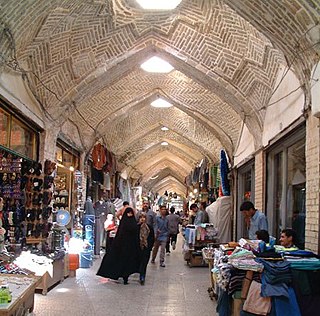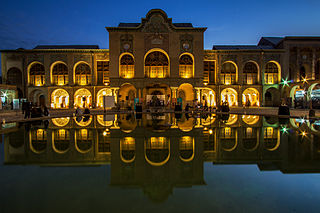
The Golestan Palace, also transliterated as the Gulistan Palace and sometimes translated as the Rose Garden Palace from Persian language, was built in the 16th century, renovated in the 18th century and finally rebuilt in 1865. It is the former official royal Qajar complex in Tehran.

Zanjan province is one of the 31 provinces of Iran. Its capital is the city of Zanjan. It is a mountainous province with close to 22,000 km2 of land placed in Iran's Region 3. Two-thirds of the people of the province live in the cities, mainly the capital and Abhar.

Amol is a city in the Central District of Amol County, Mazandaran province, Iran, serving as capital of both the county and the district.

Kerman is a city in the Central District of Kerman County, Kerman province, Iran, serving as capital of the province, the county, and the district.

Barbari bread is a type of Iranian yeast leavened flatbread. It is one of the thickest flat breads and is commonly topped with sesame or black caraway seeds. A notable characteristic of the bread is its top skin that is similar to pretzels or lye roll's skin due to the Maillard reaction that occurs during baking. Before baking it is glazed with a mixture of baking soda, flour and water. It is widely known as Persian flatbread in United States and Canada.

Ardalan was a hereditary Kurdish vassaldom in western Iran from around the 14th century until 1865 or 1868 with Sanandaj as capital. The territory corresponded roughly to present-day Kurdistan Province of Iran and the rulers were loyal to the Qajar Empire. Baban was its main rival. Gorani was the literary language and lingua franca. When the vassaldom fell, literary work in Gorani ceased.

Bijar is a city in the Central District of Bijar County, Kurdistan province, Iran, serving as capital of both the county and the district.
Qasr-e Shirin (Persian: قصرشيرين, is a city in the Central District of Qasr-e Shirin County, Kermanshah province, Iran, serving as capital of both the county and the district. Its population in 2016 was 18,473. It is a Free-trade zone and is populated by Kurds.

The East-Azerbaijan Provincial Palace is the main office for Iran's East-Azerbaijan provincial governor in downtown Tabriz. The history of the palace goes back to the Safavid and Zand dynasties, when it was named Aali Qapou. The original construction of the palace was supervised by Najaf Qoli Khan for the Safavid kings, when Tabriz was the capital of Iran. During the Qajar era, Aali Qapu served as the residence for the crown prince of Iran. It was reconstructed and repaired under Naser al-Din Shah, when its name was changed to Shams ol-Emareh. Since the Iranian Constitutional Revolution, the palace has been used as the provincial governorship office.

Sanandaj is a city in the Central District of Sanandaj County, in the Kurdistan province of Iran, serving as capital of the province, the county, and the district. With a population of 414,069, Sanandaj is the 23rd largest city in Iran and the second largest Kurdish city.
Zarrinnaal or Zarrin Naal is the name of a dynasty of Kurdish tribal chiefs and state officials belonging to the Zarrin Kafsh tribe and originated from Sanandaj in Kurdistan Province of Iran. Their heads with the title of Beyg, Beyk or Beg (lit."lord") were the Aghas of Senneh and ruled their fiefdom during the time of four hundred years when the Safavids, Afsharids and finally Qajar dynasty reigned in Iran.
Hasanabad was a village in, and the former capital of, Abidar Rural District of the Central District of Sanandaj County, Kurdistan province, Iran. The capital of the rural district has been transferred to the village of Kilaneh.
The Kurdish Philharmonic Orchestra is one of the few active classical music orchestras in Iran. It was founded in 2005 by a group of musicians in the city of Sanandaj.

The Jameh Mosque of Babol is related to the Qajar dynasty and is located in Babol, near the cultural Intersection.
Iranian Kurdistan or Eastern Kurdistan is an unofficial name for the parts of northwestern Iran with either a majority or sizable population of Kurds. Geographically, it includes the West Azerbaijan Province, Kurdistan Province, Kermanshah Province, Ilam Province and parts of Hamadan Province and Lorestan Province.

The Qajar Bathhouse is a historical bathhouse in Qazvin, Iran. It was built in 1647 in Safavid Iran by the order of the shah, and by Amingune Khan Qajar who was a Sardar of the Shah, and was initially known as the Shahi bathhouse.

The Masoudieh Mansion is a historical mansion in Tehran, Iran. It was built as a residence for the Qajar prince Mass'oud Mirza Zell-e Soltan in 1878, hence the name Masoudieh.

Kurdistan Beit-ol-Moqaddas Corps is a military unit under Basij and IRGC. Their headquarters is located in Sanandaj, and they are the largest and in charge of controlling all IRGC Corps and Basij units in Kurdistan province.
Khosrow Khan Bozorgi was the Ardalan vali (governor) of Kurdistan from 1754 to 1788/89.

















